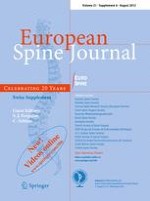01-08-2012 | Original Article
Ultrasound assessment of transversus abdominis muscle contraction ratio during abdominal hollowing: a useful tool to distinguish between patients with chronic low back pain and healthy controls?
Published in: European Spine Journal | Special Issue 6/2012
Login to get accessAbstract
Spine stabilisation exercises, in which patients are taught to preferentially activate the transversus abdominus (TrA) during “abdominal hollowing” (AH), are a popular treatment for chronic low back pain (cLBP). The present study investigated whether performance during AH differed between cLBP patients and controls to an extent that would render it useful diagnostic tool. 50 patients with cLBP (46.3 ± 12.5 years) and 50 healthy controls (43.6 ± 12.7 years) participated in this case–control study. They performed AH in hook-lying. Using M-mode ultrasound, thicknesses of TrA, and obliquus internus and externus were determined at rest and during 5 s AH (5 measures each body side). The TrA contraction-ratio (TrA-CR) (TrA contracted/rest) and the ability to sustain the contraction [standard deviation (SD) of TrA thickness during the stable phase of the hold] were investigated. There were no significant group differences for the absolute muscle thicknesses at rest or during AH, or for the SD of TrA thickness. There was a small but significant difference between the groups for TrA-CR: cLBP 1.35 ± 0.14, controls 1.44 ± 0.24 (p < 0.05). However, Receiver Operator Characteristics (ROC) analysis revealed a poor and non-significant ability of TrA-CR to discriminate between cLBP patients and controls on an individual basis (ROC area under the curve, 0.60 [95% CI 0.495; 0.695], p = 0.08). In the patient group, TrA-CR showed a low but significant correlation with Roland Morris score (Spearman Rho = 0.328; p = 0.02). In conclusion, the difference in group mean values for TrA-CR was small and of uncertain clinical relevance. Moreover, TrA-CR showed a poor ability to discriminate between control and cLBP subjects on an individual basis. We conclude that the TrA-CR during abdominal hollowing does not distinguish well between patients with chronic low back pain and healthy controls.





